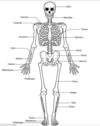Body Systems Flashcards
Respiration vs breathing.
Breathing is the physical process in which you inhale oxygen into you lungs. Respiration is a chemical reaction where oxygen is used to breakdown glucose in prefer to generate energy which is then used by the cells to function.
Explain the need for body systems.
We need body systems because each system works together to help/allow our body to function.
Outline the main organs in the respiratory system and how it works.
The main organs of the respiratory system include: the trachea which filters the air we breathe, the trachea branches in to two tubes called bronchi that lead into the lungs. Once in the lungs, the oxygen travels to the bronchioles, smaller branches that come off of the bronchi. From the bronchioles the oxygen is lead into tiny air sacks called alveoli, where gas exchange occurs.
Define mechanical and chemical digestion and describe their functions.
Mechanical digestion involves breaking the food down into smaller pieces (through chewing, etc.) Chemical digestion involves breaking down food into simpler nutrients that can be used by the cells. (E.g. starch > sucrose/sugars > glucose)
Define digestion and identify the parts and functions of the digestive system.
Digestion is the breakdown of food into small molecules, which are then absorbed into the body. The food is physically broken down by the teeth. It then moves through the oesophagus to the stomach where, through the action of enzymes, the food is chemically digested with bile from the gallbladder and then mechanically digested through the contraction of the stomach walls. The pancreas then creates pancreatic juices that help digest carbohydrates, fats and proteins. The food then moves down into the digestive tract. The muscles of the small intestine mix food with digestive juices from the pancreas and liver. The walls of the small intestine absorb water and the digested nutrients into the bloodstream. The large intestine then absorbs any extra water and changes the waste into stool. The stool then moves to your rectum where it is stored until you go to the bathroom.
Describe the diffusion of oxygen and carbon dioxide into the alveoli and the exchange of these gases in the bloodstream.
Oxygen and carbon dioxide move from where there is a high concentration to where there is a lower concentration. This movement is called diffusion. Oxygen defuses from the alveoli into the blood in the capillaries, similarly carbon dioxide from the blood moves out of the capillaries into the alveoli.
Explain how breathing rate is linked to respiration rate.
For respiration to occur you need oxygen and you get oxygen by breathing, therefore, if your breathing rate increases the rate at which respiration occurs also increases. if your breathing rate decreases the rate at which respiration occurs also decreases.
List the components of the circulatory system.
- heart - veins - arteries - capillaries
Describe the structure of the heart.

Describe the function of the heart.
The hearts function is to pump oxygenated and deoxygenated blood to the lungs and around the body.
Describe the function of arteries, veins and capillaries.
Arteries take blood away from the heart. Veins take deoxygenated blood into the heart (with the exception of the pulmonary vein). Capillaries are tiny blood vessels that are the sites of the transfer of oxygen and other nutrients from the bloodstream to other tissues in the body; they also collect carbon dioxide waste materials.
Define excretion.
The way the body gets rid of wastes it has produced.
Describe the excretory role in the lungs.
The removal of carbon dioxide and some water.
Describe the excretory role in the liver.
The removal of excess amino acids, toxins and dead red blood cells.
Describe the excretory role in the skin.
The removal of some urea through sweat.



